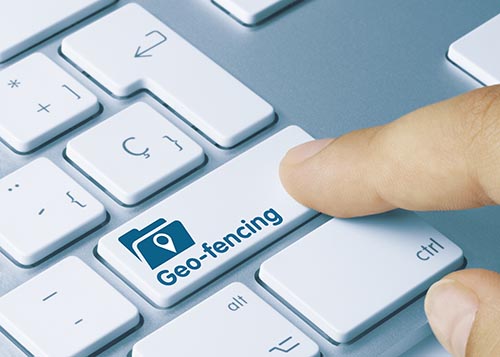Geofencing
You’ve probably heard the saying “think globally, act locally.” Well, the practice of geofencing allows marketers to act hyper-locally.
Mobile devices have become a massive part of our everyday lives. Over the past few years, as mobile phones have become more advanced and networks have expanded, mobile devices have become the preferred method of internet searches. The popularity and ease of mobile devices have changed the way we communicate, shop, seek out entertainment, and learn about new information, including new businesses. It’s no surprise that mobile convenience has changed the world of marketing, as well.
One of the most potent and exciting modes of mobile advertising is called Geofencing. The team at Newell Ledbetter Advertising is well-versed in geofencing and lucky for our clients, most companies remain in the dark when it comes to this strategy.

What You Need to Know About Geofencing
Location-based data is changing how marketers connect with potential customers and clients. Businesses and organizations now have the power to section off entire geographic areas and target people and devices within them.
Geofencing works via global positioning systems (GPS) and radio frequency identification (RFID) on mobile devices. Did you know businesses can establish “virtual barriers,” allowing administrators to communicate with devices entering, leaving, or residing within a designated area? Various triggers are set up based on a business’s marketing strategy.
These triggers can include:
- Targeted text messages
- Email alerts
- In-app notifications
- Banner Advertisements/Display Ads
Uses of Geofencing
A sign or an advertisement is effective, but it doesn’t have the immediacy of a notification on a phone or other mobile device.
Geofences can be configured in different ways to prompt a push notification to appear on someone’s phone. These notifications are tools for companies to:
- Trigger immediate sales
- Promote brand awareness and recognition
- Obtain useful shopper data and insights into their shopping intent
- Notify customers about special offers, sales, and other time-relevant information
- Offer coupons
- Provide improved “Loyalty Points” systems (no more punch-cards!)
- Gain feedback via customer surveys
The above examples are very useful for retail brands, however, there is a multitude of industries that benefit from the use of geofences.
Concert and sports venues have discovered the use of geofences to aggregate fan posts about the event. In-the-moment feedback from patrons provides valuable insights into what venue-goers like and dislike about their experience. Venues can then use this information to improve on their shortcomings and play to their strengths. Driving loyalty is also a huge benefit of geofencing. After fans have left the geofenced area, the venue can continue serving them ads to drive business back.
Keep the following elements in mind as you develop your fencing strategy:
- You don’t want to alienate users by sending too many push notifications.
- GPS-based apps are a huge drain on phone batteries, even when they’re just running in the background.
- You’ll likely need the services of technology experts, app developers, or software designers to create and maintain the geofence at optimum levels of efficacy.
- Smaller is better when it comes to a geofence; stick to the geographic area directly around your brick-and-mortar location (at least at first).
Important Takeaways for Geo-Fencing Success
Many factors go into successful geofencing, and we would love to help you get started!
Geo-fencing isn’t strictly for the “big dogs,” there is plenty of room for the smaller “chihuahua-sized” companies to get in the mix. Local retailers can take advantage of these services just as easily as the national brands. If you are interested in learning more, contact us at NLA today. We are experienced in geofencing and can take on your next campaign with proven success.
In the end, a successful geofence-based campaign is just like any other marketing strategy. The fencing process works best when it works organically. To do this, your notifications should be:
- Timely: To prompt people’s “Fear of Missing Out” (FOMO), it helps to notify customers about sales that are ending soon or limited-time offers.
- Relevant: Use shopper data to inform potential customers about the kind of products they like and enjoy seeking out. Don’t offer them something they don’t care about–that’s a one-way ticket to having your app uninstalled. Your customer data information and Google analytics can help with this.
- Useful: Don’t spam your customers! One useful notification is always better than ten that have no bearing on their lives and interests.
By following the tips given throughout this guide, we’re sure that you’ll harness the power of the geofence to boost your business, bolster your app, and see some of the best ROI of any marketing strategy you’ve used.
Why NLA Media?
- Ongoing Research
- Careful Planning
- Experience
- Proven Formulas
- Custom Strategies
- Master Negotiators
